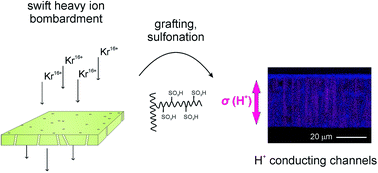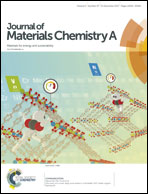Membrane architecture with ion-conducting channels through swift heavy ion induced graft copolymerization†
Abstract
Proton exchange membranes (PEMs) are of interest as key elements in various electrochemical devices, such as fuel cells, electrolyzers or flow batteries. The structure of commonly used PEMs consists of a random arrangement of proton conducting domains, formed by phase separation of hydrophilic ionomer constituents from the hydrophobic polymer backbone. This paper presents an approach for the synthesis of polymer electrolytes with proton conducting domains aligned in the through-plane direction of the membrane, prepared via swift heavy ion (SHI) irradiation followed by graft copolymerization and sulfonation to introduce proton conducting motifs. This paper presents a comprehensive discussion of the effect of SHI irradiation on the structure and fuel cell relevant properties of a PEM including performance measurements at the device (cell) level. Membranes were synthesized with various densities of proton conducting channels, which were identified via elemental mapping and electrochemical AFM. These membranes showed superior proton conductivity compared to membranes prepared by standard electron-beam induced grafting.



 Please wait while we load your content...
Please wait while we load your content...